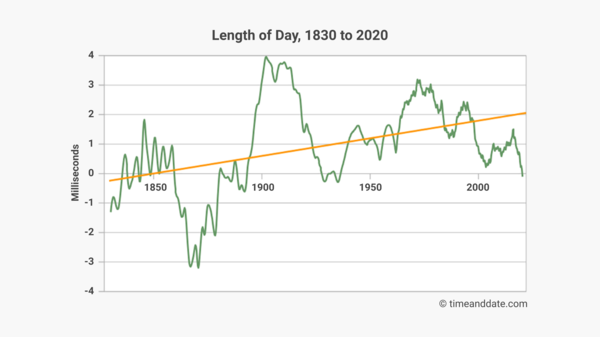The Earth Keeps Good Time
While we are constantly trying to build a better clock, it’s easy to forget there’s a very accurate timekeeper right under our feet: planet Earth.

One speed: Our globe’s rotation keeps an amazingly consistent tempo.
©iStockphoto.com/BeholdingEye
Spinning Reliably
You can literally set your watch by the movement of our planet. The speed of the globe’s spin holds to an extremely consistent tempo, one that is so precise it only varies by a few thousandths of a second, (or milliseconds), a day.
Each 24-hour period on Earth totals out to almost exactly 86,400 seconds. And because this number is so constant, we can use the duration of a day as an extremely reliable way to measure time.


The Earth’s length of day has only varied by milliseconds since 1830.
But it’s true that a small bit of variation does exist in the speed of the our rotation, mostly due to the influence of celestial neighbors like the Moon, whose gravitational pull can work to slow our globe’s spin.
Better Than Quartz
Despite the tiny changes in our rotation, planet Earth performs much more accurately than some older timekeeping technologies, such as quartz computer clocks and watches. These devices rely on a quartz crystal-controlled oscillator, which vibrates to measure time intervals. When solid-state electronics evolved in the 1970s, this kind of timekeeping became the standard technology for inexpensive consumer electronics.
But quartz devices are much less accurate than relying on the third rock from the Sun. The vibration of the quartz element decays over time, which can mean these clocks can lose up to half a second a day, adding up to large inaccuracies over time.
Interview: What do we know about spacetime?
Atomic Future
The future of super accurate timekeeping lies with atomic clocks, which manage to outperform even the Earth for precision. In these devices, a quartz oscillator is paired with a group of cesium atoms that work to “nudge” the oscillator and keep its vibrations on the mark at one second, mostly eliminating the decay problem that occurs in older quartz technology.
Another step forward in hyper-accurate timekeeping is NASA's Deep Space Atomic Clock, which was launched into orbit in 2019 and decommissioned in 2021. A new and improved version, the Deep Space Atomic Clock-2, will be onboard the VERITAS Venus mission in 2028.
Rather than use cesium atoms, the Deep Space Clock relies on mercury ions, which have a “hyperfine” transition frequency of 40.50 GHz—and this allows it to calibrate the output of the quartz oscillator even more precisely than cesium-based systems.
Timekeeping from this technology should help spacecraft improve navigation and landing on other planets. Space-based atomic clocks can provide data that can track landing sites within a margin of error of just a few meters, far outstripping Earth-based clock calculations, which can result in the target being off by kilometers.